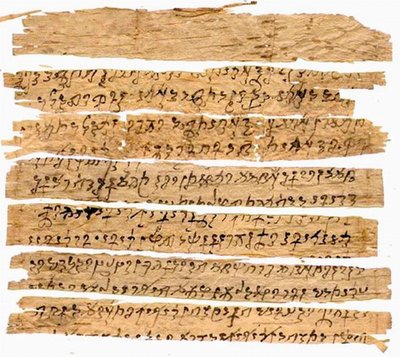August 20, 2002
One of earliest Buddhist manuscripts acquired by University of Washington
A project that is fundamentally changing the way scholars look at the ancient world and the teachings of the Buddha has received a major addition.
A birch bark manuscript from a Buddhist monastery, believed to have been written in the first or second century A.D., was recently acquired by the University of Washington Libraries and will become a key component of the Early Buddhist Manuscripts Project.
Betsy Wilson, director of UW Libraries, says, “This acquisition ensures that this important manuscript is preserved and made available to generations of scholars to come. It will enable scholars to create new knowledge and understanding from this ancient text.”
The manuscript is among the earliest Buddhist writings known to exist. A private collector who recently died owned the manuscript. The chain of possession from its location of origin to the collector is unknown.
The manuscript consists of eight fragments of a scroll and is written in the Gandhari language, a derivative of Sanskrit. The style of script and the language suggest the manuscript comes from Gandhara, a region of what is now eastern Afghanistan and northern Pakistan. Gandhara was an early, vibrant center of Buddhism and occupied a pivotal role in the spread of Buddhism from India to Central Asia, China and the rest of East Asia. Some of the most influential schools of Buddhism in the first century were located in Gandhara.
The clarity of the writing and the quality of the preservation of the new scroll are impressive, says Richard Salomon, UW professor of Asian Languages and Literature. In just a few weeks, the Early Buddhist Manuscripts Project’s team of faculty and graduate students has managed to decipher nearly three-quarters of the text. The part that remains will yield its clues only grudgingly and over a long period of time, researchers say. And deciphering the text is just the first step in analyzing the information.
Despite advances in digital technology the ability to have the original manuscript on site is of great value, Salomon says. “There are still things you can determine by looking at the original manuscript that are impossible with even the best digital images.”
If the UW had not purchased the manuscript it could well have gone back into a private collection and disappeared again from public view, Salomon says. The purchase was made possible by private donations.
The UW manuscript comes from a branch of Buddhist scholastic literature known as abhidharma. It is a commentary, offering interpretations of the Buddha’s teachings. “The topic of this text, as in many early Buddhist writings, is the problem of suffering,” says Collett Cox, UW professor of Asian languages and literature.
“This text is very exciting, because it is the earliest commentary that we’ve found. All other early texts have been extensively reworked. This is clearly in its ‘raw’ form. We can only speculate on how it was used, but it is possible that it was lecture outlines for teaching in the monastery. Buddhism was just moving from an oral tradition to writing. This manuscript will give us insight into how textual collections developed—not just how texts evolved over time, but how the monastic community used them. We will learn more about what early teachers thought was important about the history of Buddhism prior to that time, what they thought was worth passing on to future generations. We’re seeing a stage of development in the history of Buddhism of which just a few years ago we were completely ignorant.”
The UW manuscript complements another group of manuscripts acquired by the British Library in 1994, which also is thought to come from Gandhara at around the same time. Salomon and the team have been at work for the past six years, trying to decipher the letters, words and sentences in that manuscript. So far, they have published three volumes analyzing portions of the text. Until the discovery of the British Library manuscripts, no Buddhist manuscripts of this type had been found in 100 years.
The Early Buddhist Manuscripts Project is a partnership between the UW and the British Library.
“Our work is only beginning to come out and make its way into the scholarly community,” Cox says. “We definitely will not complete the work of deciphering and analyzing the texts in our lifetime.”
###
Richard Salomon can be reached at 206-543-8763 or rsalomon@u.washington.edu.

